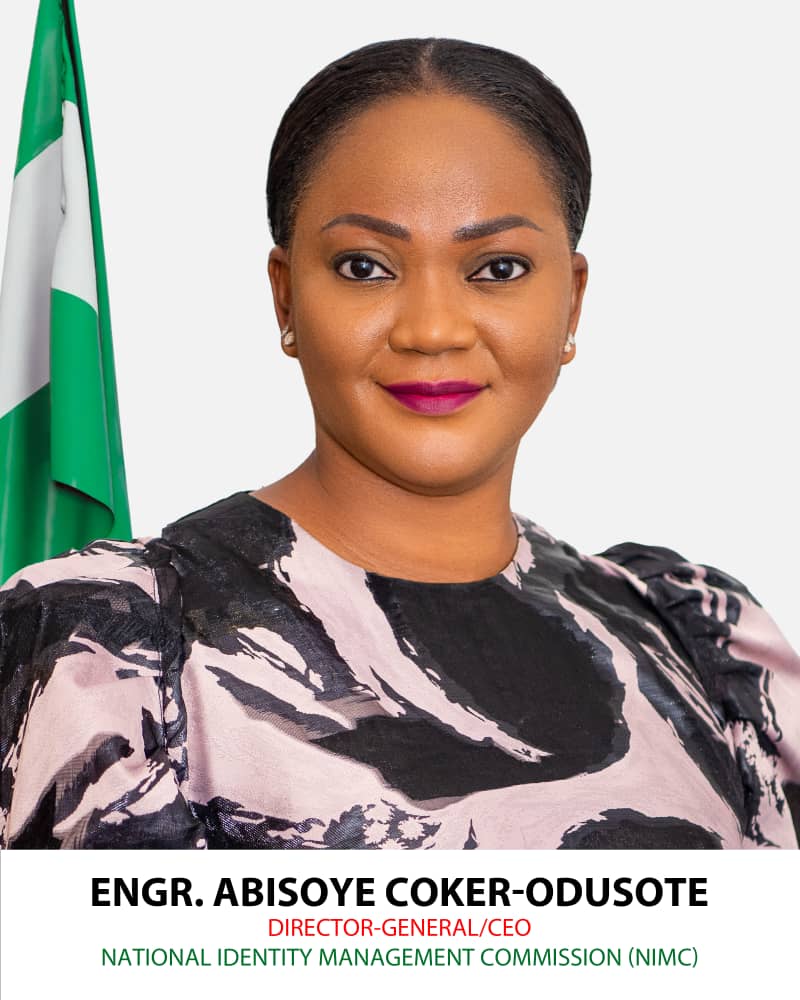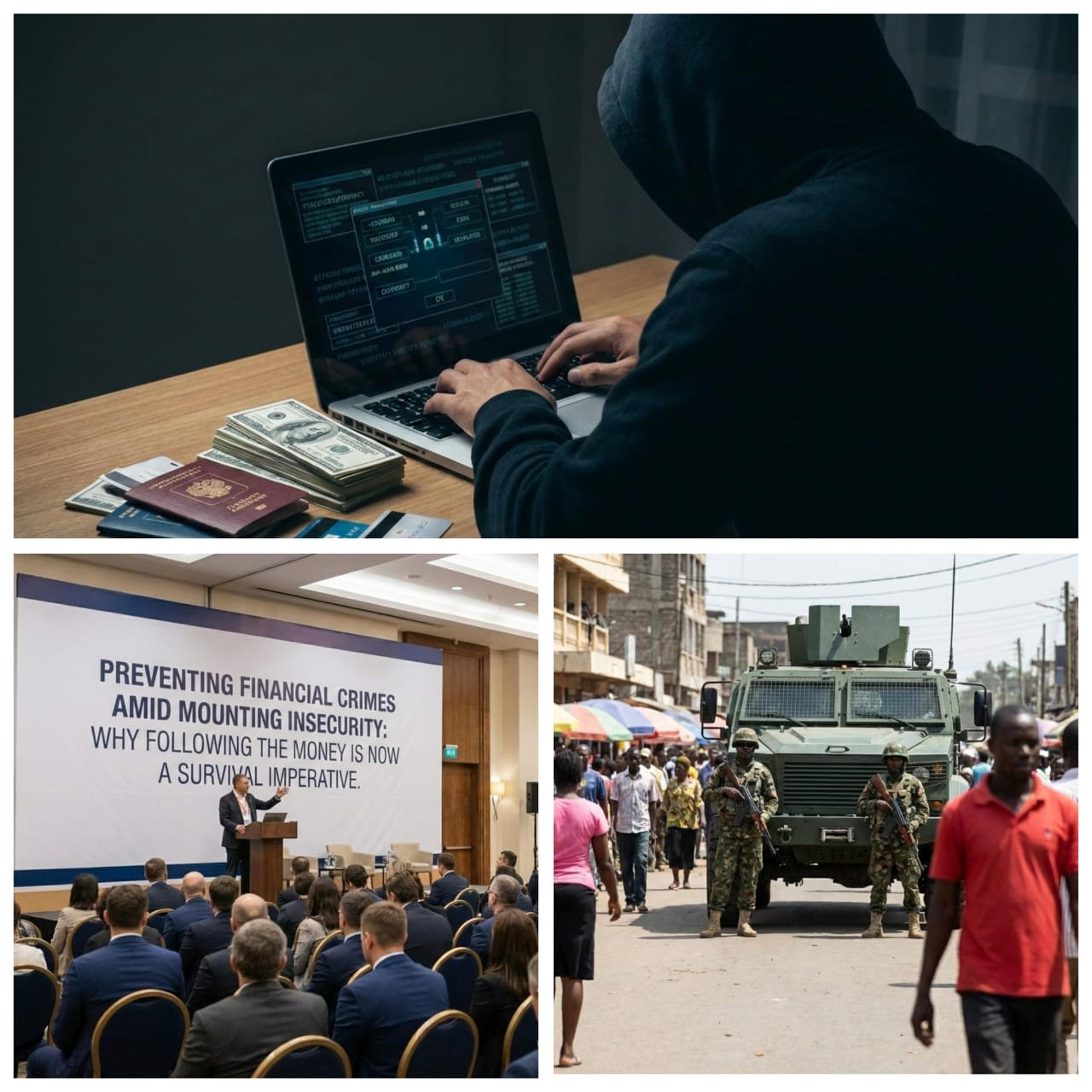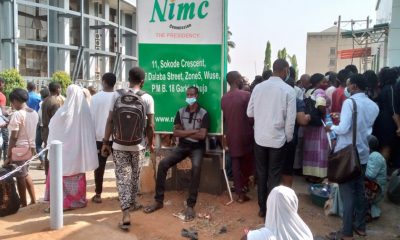Feature/OPED
Coker-Odusote: 100 Days at the Helm of NIMC

By Walter Duru, Ph.D
It was Albert Einstein who once said that “setting an example is not the main means of influencing another, it is the only means.” That sentiment expressed by Einstein is the primary essence behind the theory of transformational leadership, which requires passion, charisma, and the ability to motivate others. Transformational leaders are usually very authentic, emotionally intelligent, great listeners, results-focused, visionary, and self-aware.
In just 100 days at the helm of the National Identity Management Commission (NIMC), Engr. Abisoye Coker-Odusote has ushered in a new era of transformational leadership, leaving an indelible mark on the organization. Her eventual confirmation as substantive Director General/Chief Executive Officer of the Commission did not come to many as a surprise.
She did not waste time to hit the ground running and showed commitment to advancing the NIMC’s mission and mandate.
Coker-Odusote has taken steps to streamline National Identity Number (NIN) registration processes while addressing the long-standing challenges associated with identity registration in Nigeria. This, she is handling through strategic restructuring and the integration of advanced technologies to significantly reduce waiting time and enhance the overall efficiency of the system.
Today, date of birth and other kinds of modifications at NIMC happen within 48 hours. The several years backlog of date of birth modifications she inherited are almost cleared, as she had given a one-month deadline for the same to relevant staff of the Commission.
Again, responses to issues and complaints, such as those whose National Identity Numbers did not hit the NIN Verification Portal are now resolved within 24 hours.
Recognizing the paramount importance of data security in the digital age, the NIMC CEO has taken steps to enhance data security by introducing robust measures to fortify the protection of citizens’ sensitive information. This includes, but is not limited to the adoption of cutting-edge encryption technologies and the establishment of a dedicated cybersecurity team.
Her interest in improving service delivery at NIMC cannot be overemphasized. She has concluded plans to ensure regular training and retraining for staff of the Commission, emphasizing customer-centric approaches, to ensure a more positive experience for citizens seeking identity services.
On partnerships, Coker-Odusote, leveraging her extensive network and expertise, has forged strategic partnerships with governmental agencies, private organizations, and international bodies. These collaborations aim to enhance the NIMC’s capacity, foster innovation, and promote information sharing for the betterment of identity management.
Understanding the pivotal role of technology in modernizing identity management, Engr. Coker-Odusote has spearheaded the integration of biometric advancements and artificial intelligence into the registration and verification processes.
This not only improves accuracy, user experience and ease of enrolment, but also positions NIMC at the forefront of technological innovation in identity management. A typical example is the NIMC Contactless Biometric Solution, which delivers a best-in-class fingerprint and facial capture image output quality, powered by Artificial Intelligence. The new solution was unveiled by the commission at the 2023 Identity Day, held in Abuja on September 16, 2023.
In addition, Engr. Coker-Odusote tackled the existing backlog of unprocessed identity requests head-on. Through a combination of strategic staff deployment and redeployment, process optimization, and digitization initiatives, she has made significant strides in clearing the backlog, demonstrating her commitment to prompt and efficient service delivery.
Recognizing the crucial role played by the NIMC staff in achieving organizational goals, the CEO has developed for implementation, a robust welfare programme aimed at boosting morale and fostering a positive work environment. This includes, but is not limited to training opportunities, health benefits, and performance recognition initiatives.
Furthermore, in consultation with in-house experts, elaborate public awareness campaigns are being planned, to ensure that citizens are well-informed about the importance and benefits of identity registration. These campaigns are expected to not only educate the public but also serve to demystify the registration process, encouraging greater participation.
The NIMC DG has concluded plans to take the ecosystem enrolment forward by taking steps to deepen collaboration with ecosystem implementing partners, supporting to ensure the success and optimal performance of the Nigeria Digital Identification for Development (ID4D) Project, a Nigerian Project jointly funded by The World Bank, The European Investment Bank, and the French Development Agency.
Engr. Coker-Odusote’s strategic vision, commitment to efficiency, and emphasis on technological innovation positions NIMC for a future where identity management is not only secure but also seamlessly integrated into the daily lives of citizens.
On anti-corruption, the NIMC DG has left no one in doubt about her determination to sanitize the system and entrench a culture of transparency and zero tolerance for corruption. Apart from putting systems and structures in place to discourage graft, she is directly involved in ensuring that the cankerworm has no place in the commission.
Just recently, in what one may describe as a sting operation, she paid an unscheduled visit to the Federal Capital Territory office of the commission, where she is reported to have arrested some staff for allegedly extorting money from Nigerians, even as she has maintained that enrolment was free.
Her devotion to supporting the policy direction of the present administration by strengthening the issuance of the NIN for access to service is not in doubt.
Speaking on Coker-Odusote’s first 100 days in office as NIMC CEO, and Project Coordinator, Nigeria Digital ID4D Project, Musa Odole Solomon described her as a vibrant, results-focused leader, determined to make a difference in the Commission.
“She has taken steps to build bridges of collaboration between NIMC and partners within the country’s identity ecosystem. These collaborations aim to enhance the NIMC’s capacity, foster innovation, and promote information sharing for the betterment of identity management in Nigeria.”
“The collaboration is also focused on enhancing handshake with institutions involved in the country’s identity ecosystem, to deepen integration with the country’s Identity Management System.”
“In 100 days, she has taken the lead in working with the Nigeria Digital ID4D Project to speed up the project implementation process, especially, processes geared towards the extension of NIN enrolment to hard-to-reach areas, women, persons with disabilities, and marginalized groups, thereby fostering inclusion and access to social services.”
“She has introduced some innovations that I consider very progressive, and things are moving very well. The Nigeria Digital ID4D Project is happy to work with her, as she has shown that she has all it takes to assist us succeed.”
Responding to a question on his impression about the NIMC DG’s leadership style and the future of the relationship between NIMC and his organisation, the Chairman of the National Population Commission (NPC), Hon. Nasir Isa Kwarra stressed that the relationship between NIMC and NPC has become more robust under Coker-Odusote’s leadership as NIMC CEO.
“I want to say that the National Population Commission has a long and robust collaborative partnership with the National Identity Management Commission (NIMC) in our efforts to harmonize and integrate biometric databases for planning and development of our country.”
“However, this partnership has become more dynamic and robust with the assumption into office of Engr. Abisoye Coker-Odusote as the Director General of NIMC. She has shown an unparalleled commitment and passion in working with the Commission, not only in the registration of births and deaths but also in the upcoming population census. She comes across as a thoroughbred professional and innovator who will give Africa’s greatest nation a deserved identity profile for national unity, security, and development. I am more confident in the future of the Identity Management Commission under her.”
Responding to a question on the new grounds covered at the NIMC ICT, Director, IT/Identity Database of the Commission, Chuks Onyepunuka has this to say:
“Our DG is pragmatic, proactive, result-oriented and visionist. Her achievements in ICT in NIMC in the last 100 days include, but are not limited to: “launching of self-modification and enrolments services to ease and simplify the processes for enrolment services; driving the clearing of about 3 million backlog of enrolment records awaiting manual adjudication within 3 weeks; decentralization of operations with objectives of ensuring that we are closer to the enrolees and adequate coverage in the nooks and crannies of the country.”
“Others are improvement in the process of engaging and revalidating our Frontend Enrolment Partners (FEPs); improvement in our ICT policies, processes and procedures; resolution of 95% challenges/issues affecting our window enrolment software (Res-Web) and commenced the integration and harmonization with National Population Commission, Nigeria Immigration Service and Federal Inland Revenue Service (FIRS).”
Adding her voice, NIMC’s Director of Business Development and Commercial Services, Mrs Carolyn Folami described the DG as a thoroughbred professional, committed to resetting the Commission for the good of the nation.
“It has been only 100 days, but it seems she has been here far longer, as, within this period, we have achieved a couple of goals towards resetting the NIMC agenda and resettling the NIMC staff for productivity.”
“Starting with the planning and commencement of training of all staff, to the commitment to all Front-End Partners (FEP) to revalidate the business model for fair play and payment. She is very keen on stakeholder engagement and has secured the buy-in of our harmonisation partners for effectiveness. She is professional, thorough, dedicated, and above all, kind to all.
Adding his voice, Monitoring and Evaluation Specialist, Project Implementation Unit, Nigeria Digital ID4D Project, Dr Emmanuel Akogun argued that Coker-Odusote’s first 100 days in office were characterised by “dynamic, focused and results–oriented leadership,” adding that there is steady progress in NIN enrolment, with “103,500,000 Nigerians and other legal residents captured in the NIMC Database.”
There is therefore no gainsaying the fact that Engr. Abisoye Coker-Odusote’s first 100 days as CEO of the NIMC have been marked by a series of commendable achievements.
At this point, one can confidently say that with Engr. Bisoye Coker-Odusote as Chief Executive Officer, NIMC is in safe hands.
Her recent confirmation as substantive Director General/CEO of the Commission is an act of patriotism by the Nigerian President, Bola Ahmed Tinubu.
However, as she commences a full tenure of office, following her recent confirmation, one expects that the standard is not lowered.
As she marks 100 days in office this week, the most challenging part of Abisoye Coker-Odusote’s journey as Chief Executive Officer of the NIMC is the need to sustain the successes recorded, remain focused, deepen stakeholder engagement and public enlightenment, check corruption, strengthen systems and structures, be fair to all, while supporting the policy direction of the present administration.
Deliberate steps must be taken to ensure the sustenance of the war against extortion at NIMC.
Again, a deliberate plan should be in place to ensure a more robust stakeholder collaboration, particularly with those involved in the country’s identity ecosystem.
Elaborate, sustained communication and public enlightenment activities are required, taking advantage of the conventional and unconventional channels of communication to inform, educate and mobilize the citizens on the need for all to register for the NIN. This requires a deliberate strategy and strategic implementation.
Finally, a deliberate inclusion strategy must be in place and vigorously implemented to ensure that no one is left behind.
As the DG continues to lead with passion and purpose, NIMC is poised for even greater accomplishments under her guidance.
Indeed, NIMC is in safe hands!
Dr Walter Duru (Assistant Professor of Communication and Multimedia Design) is a Communication/Public Relations Strategist, Researcher and Consultant. He could be reached at [email protected]
Feature/OPED
Preventing Financial Crimes Amid Mounting Insecurity: Why Following the Money is Now a Survival Imperative

By Blaise Udunze
Nigeria today faces a sobering dual reality: a deepening security crisis and an entrenched financial-crime ecosystem that quietly feeds, sustains, and normalises that crisis. Across the North, Middle Belt, and parts of the South, kidnappers, bandits, insurgent cells, political actors, compromised security agents, and a complex chain of financial facilitators operate within a shadow economy of violence, one that generates billions, claims thousands of lives, and steadily erodes the authority of the state.
For over a decade, security experts and Nigeria’s international partners have warned that no meaningful progress will be made against insecurity unless the financial oxygen sustaining violence is cut off. Yet the country continues to prosecute its anti-terrorism efforts largely through military responses, as though the conflict could be resolved solely on the battlefield. What remains missing is a decisive, transparent, and politically courageous confrontation with the economic networks that make insecurity profitable.
This war is not only about guns and bullets. It is about money.
Money moves fighters.
Money buys weapons.
Money fuels political desperation.
Money underwrites chaos.
Until Nigeria addresses the financial pipelines behind its insecurity, the crisis will continue to reproduce itself.
Kidnapping: The Lucrative ‘War Fund’ Sustaining Insurgency
The rise in mass kidnappings is neither accidental nor spontaneous. It has evolved into a rational, structured, revenue-generating enterprise.
Appearing on Channels TV’s Politics Today in October 2025, Yusuf Datti Baba-Ahmed warned that insurgent and bandit groups now treat ransom payments as reliable “war funds.” The data support his claim.
A 2024 survey by the National Bureau of Statistics (NBS) found that Nigerians paid N2.2 trillion in ransom between May 2023 and April 2024. This astonishing sum does not account for unreported payments made through informal negotiators, mobile transfers, or unregulated community channels.
Kidnapping has matured into a fully formed economy with well-defined roles: negotiators, informants, logistics providers, cash couriers, and security collaborators. Proceeds are reinvested in weapons, motorcycles, communication devices, safe houses, and even land acquisitions.
In the words of a security analyst, “Every successful kidnapping is a fundraiser.”
Sabotage from Within: Keffi’s Explosive Memo and a System Built to Fail
If Nigeria’s external security threats are troubling, the internal compromises are even more alarming.
A leaked memo by Major General Mohammed Ali Keffi accused senior government and military officials of diverting billions of naira earmarked for arms procurement under former Chief of Army Staff, Lt. Gen. Tukur Buratai. Keffi’s allegations included:
– Weapons paid for but never delivered
– Falsified battlefield reports
– Civilian casualties mislabelled to justify inflated expenditures
– Political interference obstructing investigations into terror financing
His claims echoed the earlier warning by Gen. T.Y. Danjuma, who accused sections of the military of working in concert with armed groups and abandoning vulnerable communities.
Keffi’s memo became even more consequential following the 2025 detention of former Attorney General Abubakar Malami by the EFCC over allegations of money laundering, terrorism financing and suspicious financial activity linked to 46 bank accounts.
Together, these revelations paint a disturbing picture: even as Nigerians endure mass abductions, elements within the political and security elite appear to be enabling or shielding the financial networks behind the violence.
Why the Crisis Persists: A Financial Crime Lens
Nigeria’s insecurity cannot be divorced from the environment in which illicit finance thrives. Key enablers include:
- Informal Economies and Unregulated Cash Flows
With over 70 percent of rural transactions still cash-based, terror groups exploit:
– Hawala networks
– POS and mobile-money agents
– Cattle markets and mining sites
– Barter systems centred on livestock and grains
These channels operate beyond the reach of AML/CFT systems.
- Identity Fraud and Weak KYC Enforcement
– Criminal networks routinely open accounts with:
– Fake NINs
– Compromised SIM cards
– Recycled BVNs
– Mule identities
- Collusion within Financial Institutions
The EFCC estimates that up to 70 percent of financial crimes involve bank personnel, primarily through:
– Unauthorised cash withdrawals
– Suppressed Suspicious Transaction Reports (STRs)
– Manipulated internal alerts
- Weak Prosecution and Political Interference
Cases drag on for years, and many evaporate entirely before reaching court often due to political considerations.
- Ungoverned Spaces
Large territories across the North serve as hubs for:
– Arms trafficking
– Illegal mining
– Kidnap-for-ransom camps
– Cross-border smuggling
Public Patience Thins: NLC Moves to the Streets
Public frustration is reaching a boiling point. On December 10, the Nigeria Labour Congress (NLC) announced a nationwide protest scheduled for December 17, citing the “degenerating security situation” and the rise in mass abductions.
The NLC condemned the November 17 abduction of female students in Kebbi, noting that security personnel had been withdrawn from the school shortly before the attack. The union called the act “dastardly and criminal” and directed all affiliates and civil-society partners to fully mobilise for the protest.
This marks a significant shift. For the first time in years, Nigeria’s most influential labour body is placing insecurity at the centre of national mobilization, further underscoring the argument that the current crisis is not simply a security failure but a systemic breakdown of governance, accountability, and financial integrity.
The Financial Engine of Terror: The 23 Suspects Who Moved Billions
A Sahara Reporters investigation uncovered a network of 20 Nigerians and three foreign nationals allegedly linked to the financing of Boko Haram and ISWAP. Their transactions, running into hundreds of billions, were quietly channeled through personal and corporate accounts.
Among those named:
– Alhaji Saidu Ahmed, Zaria businessman: N4.8bn inflows
– Usaini Adamu, Kano trader with 111 accounts: N43bn inflows, N50bn outflows
– Muhammad Sani Adam, forex and precious stones dealer: N54bn across 41 accounts
– Yusuf Ghazali, a forex trader linked to UAE-convicted terrorists, operated 385 accounts
– Ladan Ibrahim, a Sokoto official, is accused of diverting public funds
– Foreign actors included the late Tribert Ayabatwa (N67bn inflows) and Nigerien arms dealer Aboubacar Hima, who moved over $1.19 million.
Strikingly, several of the suspects arrested in 2021 were quietly released without trial, continuing a pattern of impervious investigations and political bottlenecks.
This network confirms a painful truth: Nigeria’s insecurity is not driven solely by men wielding rifles in the bush. It is sustained by individuals in cities, businesses, and bureaucracies, people with access, influence, and remarkable financial mobility.
The Political Dimension: Irabor’s Revelation and the Unnamed Sponsors
The political undertone of Nigeria’s insecurity was reinforced by the former Chief of Defence Staff, Gen. Lucky Irabor (rtd), who admitted that politicians were among those financing terror groups. According to him, some trials were conducted “away from public consumption.”
His statement revived key questions:
– Why is the state shielding the identities of terror sponsors?
– Who benefits from the secrecy?
– What political consequences are being avoided?
Security sources told TruthNigeria that Nigeria’s published list of 19 terror financiers in 2024 represented only a fraction of the full network.
Baba-Ahmed’s accusation that former Kaduna Governor Nasir El-Rufai was part of the political forces that aggravated Northern insecurity, an accusation the former governor has previously denied, adds further urgency to demands for transparency.
The Human Cost: Expanding Killing Fields
Despite repeated assurances, violence continues to spread:
– 303 students and 12 teachers abducted in Niger State
– 38 worshippers kidnapped in Kwara
– Simultaneous raids across Plateau, Kaduna, Benue, and Niger
– Whole communities uprooted by weekly attacks
As Amnesty International observed, “In many rural communities, only the graveyards are expanding.”
SBM Intelligence now describes large portions of the North as “open killing fields,” areas where the state’s influence has collapsed, and community vigilantes have become the default security providers.
Expert Voices: Why Nigeria Must Finally Follow the Money
Security experts converge on a single message: Nigeria cannot defeat terrorism without dismantling its financial infrastructure. Dr. Friday Agbo, a security researcher, disclosed, “Terror groups survive because their financial lifelines remain untouched.”
Jonathan Asake, analyst and former SOKAPU president, said, “Publish the full Dubai list. Without transparency, impunity will remain the norm.”
Gen. Irabor (rtd.) revealed, “There are politicians involved. The conflict is multi-layered: ideology, criminality, and political manipulation.”
These assessments underscore one reality: ideology is secondary. Money is primary. It is the oxygen of Nigeria’s terror landscape.
What Must Change
Nigeria must elevate financial crime to the level of a national-security emergency. Key reforms include:
– Integrating BVN-NIN-SIM identity databases and upgrading real-time monitoring
– Targeting illicit markets: illegal mining hubs, cattle markets, unregulated border posts
– Deploying AI-driven analytics to detect layered transactions, mule networks, and ransom flows
– Strengthening bank compliance units and protecting whistleblowers
– Improving inter-agency intelligence sharing (EFCC, NFIU, DSS, NDLEA, Police, CBN)
– Criminalising unexplained wealth, especially in conflict zones
– Investing in safe-school infrastructure, rural policing, and local reporting channels
Choosing Truth Over Convenience
Nigeria’s two-front war is neither mysterious nor new. It is a well-documented, financially engineered crisis protected by silence, vested interests, and institutional decay. The NLC’s mobilisation signals a turning point; citizens are unwilling to accept official evasions while insecurity intensifies. To end this crisis, Nigeria must:
– Expose and prosecute terror financiers
– Purge corrupt insiders in the security system
– Dismantle ransom economies
– Strengthen financial intelligence
– End political protection for criminal networks
Until these reforms are pursued with integrity, billions will continue to move, weapons will continue to flow, and Nigeria will continue to bleed.
Blaise, a journalist and PR professional, writes from Lagos, can be reached via: [email protected]
Feature/OPED
Championing Ethical Sourcing Within Dairy Communities

Human Rights Day often centres on themes of dignity, equity, and freedom. Yet for many Nigerians, these rights are not debated in courtrooms they are expressed in the ability to access nutritious food, build meaningful livelihoods, and secure a healthy future for their families. Nutrition, in this sense, becomes a fundamental human right.
Despite a growing population and rising nutrition needs, Nigeria faces a pressing dairy reality. The country remains heavily dependent on dairy imports, leaving nutritional access vulnerable and local capacity underdeveloped. This is not just an economic concern; it is a human one. When families cannot easily access affordable, high-quality dairy, the foundations of health and development are weakened.
It is within this context that Arla Nigeria operates not merely as a dairy company, but as a nutrition powerhouse committed to nourishing a nation. Our ambition extends beyond selling products. We are working to build the foundations of a stronger, more resilient local dairy sector that supports food security, economic participation, and national progress.
At the heart of our efforts is the Damau Integrated Dairy Farm in Kaduna Statea fully operational modern farm designed to demonstrate what responsible, efficient, and scalable dairy production can look like in Nigeria. Arla Nigeria produces its own milk on-site, ensuring quality, safety, and consistency as we continue building the systems required for a sustainable local value chain. In fact, until our yoghurt factory launches, the reverse is true: some stakeholders purchase milk from us.
But infrastructure alone is not the story. What truly matters is the human impact surrounding the farm.
Arla Nigeria has been intentional about engaging and empowering the communities around Damau. By creating employment opportunities for local residents, providing skills development, and contributing to community growth, we are ensuring that the benefits of dairy development extend beyond production lines. This is development rooted in people where progress is measured in livelihoods improved and opportunities created.
As Arla Nigeria continues to expand operations, our long-term commitment remains clear: to contribute meaningfully to local milk sourcing and value chain development, strengthening Nigeria’s capacity to feed itself. Backward integration is not a slogan for Arla Foods; it is a structured pathway with building responsibly and sustainably. From farm systems to future household milk initiatives, the goal is to create a model that supports farmers, enhances productivity, and drives economic inclusion in the years ahead.
On Human Rights Day, the conversation often revolves around preventing harm avoiding exploitation, ensuring fair labour, and upholding ethical standards. These are essential, but they are only the beginning. True respect for human rights means creating enabling systems that allow people to thrive.
With Arla Foods, that begins with nutrition. Milk is a super food, rich in essential nutrients that support growth and development. Ensuring access to such nutrition contributes directly to national well-being and productivity. When we help secure a healthier population, we strengthen the foundation for education, economic participation, and long-term prosperity.
This is why Arla believes that dairy is not just food it is nutrition, livelihood, and progress. By investing in sustainable production, community development, and future local sourcing capabilities, Arla Nigeria is contributing to food security and economic growth in a tangible, measurable way.
Ultimately, ethical business is not defined by corporate language or labels. It is defined by the stability, nourishment, and dignity it brings to people’s lives. As Nigeria celebrates Human Rights Day, let us recognise that the right to nutrition and the opportunity to build a better future are among the most powerful rights we can help protect.
Feature/OPED
In Praise of Nigeria’s Elite Memory Loss Clinic

By Busayo Cole
There’s an unacknowledged marvel in Nigeria, a national institution so revered and influential that its very mention invokes awe; and not a small dose of amnesia. I’m speaking, of course, about the glorious Memory Loss Clinic for the Elite, a facility where unsolved corruption cases go to receive a lifetime membership in our collective oblivion.
Take a walk down the memory lane of scandals past, and you’ll encounter a magical fog. Who remembers the details of the N2.5 billion pension fund scam? Anyone? No? Good. That’s exactly how the clinic works. Through a combination of political gymnastics, endless court adjournments, and public desensitisation, these cases are carefully wrapped in a blanket of vagueness. Brilliant, isn’t it?
The beauty of this clinic lies in its inclusivity. From the infamous Dasukigate, which popularised the phrase “arms deal” in Nigeria without actually arming anything, to the less publicised but equally mystifying NDDC palliative fund saga, the clinic accepts all cases with the same efficiency. Once enrolled, each scandal receives a standard treatment: strategic denial, temporary outrage, and finally, oblivion.
Not to be overlooked are the esteemed practitioners at this clinic: our very own politicians and public officials. Their commitment to forgetting is nothing short of Nobel-worthy. Have you noticed how effortlessly some officials transition from answering allegations one week to delivering keynote speeches on accountability the next? It’s an art form.
Then there’s the media, always ready to lend a hand. Investigative journalists dig up cases, splash them across headlines for a week or two, and then move on to the next crisis, leaving the current scandal to the skilled hands of the clinic’s erasure team. No one does closure better than us. Or rather, the lack thereof.
And let’s not forget the loyal citizens, the true heroes of this operation. We rant on social media, organise a protest or two, and then poof! Our collective short attention span is the lifeblood of the Memory Loss Clinic. Why insist on justice when you can unlook?
Take, for example, the Halliburton Scandal. In 2009, a Board of Inquiry was established under the leadership of Inspector-General of Police, Mike Okiro, to investigate allegations of a $182 million bribery scheme involving the American company Halliburton and some former Nigerian Heads of State. Despite Halliburton admitting to paying the bribes to secure a $6 billion contract for a natural gas plant, the case remains unresolved. The United States fined the companies involved, but in Nigeria, the victims of the corruption: ordinary citizens, received no compensation, and no one was brought to justice. The investigation, it seems, was yet another patient admitted to the clinic.
Or consider the Petroleum Trust Fund Probe, which unraveled in the late 1990s. Established during General Sani Abacha’s regime and managed by Major-General Muhammadu Buhari, the PTF’s operations were scrutinised when Chief Olusegun Obasanjo assumed office in 1999. The winding-down process uncovered allegations of mismanagement, dubious dealings, and a sudden, dramatic death of a key figure, Salihijo Ahmad, the head of the PTF’s sole management consultant. Despite the drama and the revelations, the case quietly faded into obscurity, leaving Nigerians with more questions than answers.
Then there is the colossal case of under-remittance of oil and gas royalties and taxes. The Federal Government, through the Special Presidential Investigatory Panel (SPIP), accused oil giants like Shell, Agip, and the NNPC of diverting billions of dollars meant for public coffers. Allegations ranged from falsified production figures to outright embezzlement. Despite detailed accusations and court proceedings, the cases were abandoned after the SPIP’s disbandment in 2019. As usual, the trail of accountability disappeared into thin air, leaving the funds unaccounted for and the public betrayed yet again.
Of course, this institution isn’t without its critics. Some stubborn Nigerians still insist on remembering. Creating spreadsheets, tracking cases, and daring to demand accountability. To these radicals, I say: why fight the tide? Embrace the convenience of selective amnesia. Life is easier when you don’t worry about where billions disappeared to or why someone’s cousin’s uncle’s housemaid’s driver has an oil block.
As World Anti-Corruption Day comes and goes, let us celebrate the true innovation of our time. While other nations are busy prosecuting offenders and recovering stolen funds, we have mastered the fine art of forgetting. Who needs convictions when you have a clinic this efficient? Oh, I almost forgot the anti-corruption day as I sent my draft to a correspondent very late. Don’t blame me, I am just a regular at the clinic.
So, here’s to Nigeria’s Memory Loss Clinic, a shining beacon of how to “move on” without actually moving forward. May it continue to thrive, because let’s face it: without it, what would we do with all these unsolved corruption cases? Demand justice? That’s asking a lot. Better to forget and focus on the next election season. Who knows? We might even re-elect a client of the clinic. Wouldn’t that be poetic?
Now, if you’ll excuse me, I have a new scandal to ignore.
Busayo Cole is a Branding and Communications Manager who transforms abstract corporate goals into actionable, sparkling messaging. It’s rumored that 90% of his strategic clarity is powered by triple-shot espresso, and the remaining 10% is sheer panic. He can be reached via busayo@busayocole.com.
-

 Feature/OPED6 years ago
Feature/OPED6 years agoDavos was Different this year
-
Travel/Tourism9 years ago
Lagos Seals Western Lodge Hotel In Ikorodu
-

 Showbiz3 years ago
Showbiz3 years agoEstranged Lover Releases Videos of Empress Njamah Bathing
-

 Banking7 years ago
Banking7 years agoSort Codes of GTBank Branches in Nigeria
-

 Economy3 years ago
Economy3 years agoSubsidy Removal: CNG at N130 Per Litre Cheaper Than Petrol—IPMAN
-

 Banking3 years ago
Banking3 years agoFirst Bank Announces Planned Downtime
-

 Banking3 years ago
Banking3 years agoSort Codes of UBA Branches in Nigeria
-

 Sports3 years ago
Sports3 years agoHighest Paid Nigerian Footballer – How Much Do Nigerian Footballers Earn















